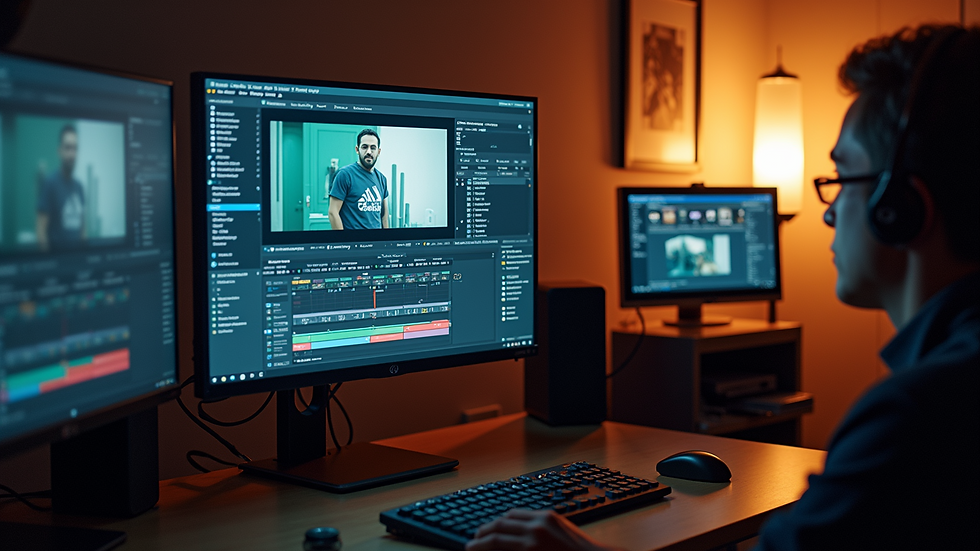Master Advanced Color Grading Techniques
- Luis Hernandez de la Peña
- Aug 16
- 4 min read
Color grading is not just a step in post-production; it’s the heartbeat of visual storytelling. When done right, it transforms raw footage into a cinematic masterpiece that captivates and communicates emotion. Today, we're diving deep into advanced color grading techniques that elevate your work from good to unforgettable. Whether you’re refining a commercial or crafting a film, these insights will sharpen your skills and inspire your creativity.
Unlocking the Power of Advanced Color Grading Techniques
Advanced color grading is about more than adjusting brightness or contrast. It’s a sophisticated craft that blends technical precision with artistic vision. To master it, you need to understand how to manipulate color spaces, use secondary color corrections, and apply creative LUTs (Look-Up Tables) effectively.
Understanding Color Spaces and Their Impact
Color spaces define the range of colors your footage can display. Working in the right color space ensures your colors remain vibrant and true to your vision. For example, grading in Rec. 709 is standard for HD content, but if you’re working with HDR or cinema projects, mastering Rec. 2020 or ACES color spaces is essential.
Rec. 709: Ideal for broadcast and online HD content.
Rec. 2020: Expands color range for HDR content.
ACES: Industry standard for feature films, offering a wide gamut and dynamic range.
By mastering these, you control how colors translate across different screens and environments, ensuring consistency and impact.
Secondary Color Correction: Targeted Precision
Primary corrections adjust the overall image, but secondary color correction lets you isolate and tweak specific colors or areas. This technique is invaluable when you want to:
Enhance a subject’s skin tone without affecting the background.
Make a product’s color pop in an advertisement.
Correct color casts in shadows or highlights selectively.
Using masks, qualifiers, and power windows, you can isolate hues and adjust saturation, luminance, and hue with surgical precision. This technique breathes life into your footage, making it feel more natural and polished.

Creative LUTs: The Artistic Edge
LUTs are powerful tools that apply a preset color transformation to your footage. While many use LUTs as a quick fix, advanced colorists treat them as a starting point or creative layer. You can:
Combine multiple LUTs for unique looks.
Modify LUTs to fit your project’s mood.
Create custom LUTs tailored to your style.
Experimenting with LUTs allows you to develop a signature aesthetic that sets your work apart. Remember, LUTs are not a one-size-fits-all solution; they require thoughtful integration into your grading workflow.
Harnessing Tools and Techniques for Flawless Results
The right tools empower your creativity and precision. Here’s how to leverage them effectively.
Scopes: Your Visual Compass
Scopes like waveform monitors, vectorscopes, and histograms are indispensable. They provide objective data about your image’s exposure, color balance, and saturation. For example:
Use the waveform monitor to check luminance levels and avoid clipping.
The vectorscope helps you maintain accurate skin tones and color balance.
The histogram reveals the distribution of brightness across your image.
Regularly referencing scopes ensures your creative choices are technically sound, preventing surprises on different displays.
Power Windows and Masks: Focused Adjustments
Power windows and masks allow you to isolate areas for targeted grading. For instance, you can brighten a subject’s face while keeping the background moody and dark. This technique adds depth and directs viewer attention exactly where you want it.
Use soft edges on masks to blend adjustments naturally.
Animate masks to follow moving subjects for dynamic scenes.
Combine multiple masks for complex corrections.
These tools give you control over every pixel, making your grade feel intentional and cinematic.

Noise Reduction and Sharpening: Polishing the Image
Noise can distract from your grade’s impact, especially in low-light footage. Advanced noise reduction techniques clean up grain without sacrificing detail. Follow this with subtle sharpening to enhance textures and edges, giving your image a crisp, professional finish.
Apply noise reduction selectively to avoid softening important details.
Use sharpening sparingly to maintain a natural look.
Balance both to preserve the integrity of your footage.
These finishing touches elevate your grade from raw to refined.
Integrating Color Grading Education Into Your Workflow
Continuous learning is key to mastering advanced color grading techniques. I recommend exploring resources like CAMARENA Color Grading School to deepen your understanding and stay updated with industry trends.
Practical Tips for Ongoing Improvement
Analyze films and commercials you admire. Break down their color palettes and grading styles.
Practice with diverse footage to adapt your skills to different lighting and moods.
Seek feedback from peers and mentors to refine your approach.
Stay current with software updates and new tools.
By embedding education into your daily routine, you build confidence and versatility that shine through in every project.

Elevate Your Visual Storytelling with Advanced Techniques
Mastering advanced color grading techniques transforms your work into a powerful narrative tool. It’s about more than aesthetics; it’s about evoking emotion, guiding the viewer’s eye, and enhancing the story’s impact.
Use color contrast to create tension or harmony.
Employ color symbolism to reinforce themes.
Balance warm and cool tones to set mood and atmosphere.
Each decision you make in grading shapes how your audience experiences the story. Embrace this responsibility with enthusiasm and precision.
Your Next Step in Color Grading Mastery
Now that you’ve explored these advanced techniques, it’s time to put them into practice. Experiment boldly, refine your workflow, and never stop learning. The world of color grading is vast and full of creative possibilities.
Remember, the journey to mastery is ongoing. With dedication and the right resources, you’ll elevate your craft and create visuals that resonate deeply. Dive into the art and science of color grading, and watch your projects come alive like never before.








Comments